Updated on April 2023
11 Tips to Cook With a Wok on a Gas Stove
Wokware is reader supported. When you buy through links on our site, we may earn an affiliate commission. Learn Here.
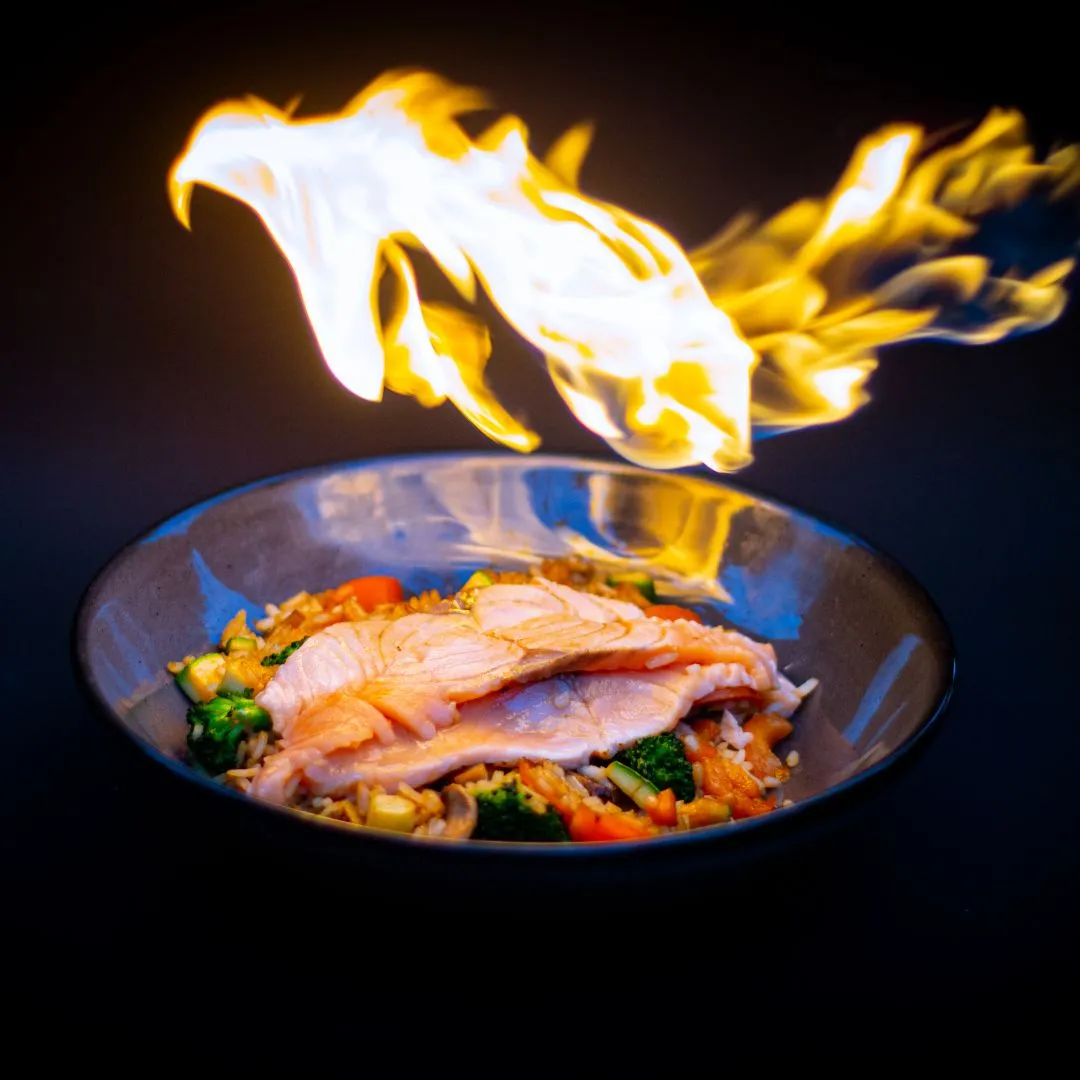
Summary:
The best way to cook with a wok on a gas stove is to use the highest flame, a seasoned wok that isn't much larger than the gas hob, keep 2/3rd of the wok empty for better heat conductivity, and and use a high smoking point oil, such as grapeseed oil. For the best results, choose a carbon steel wok at all times.
Wok cooking on a gas stove can be overwhelming, especially if you are not familiar with the correct steps. The main difference between a Chinese restaurant stir fry and a home-cooked stir fry meal is the heat source.
The blistering high heat used in restaurants is often between 100, 000 BTU – 150, 000 BTU. Whereas, our gas stove produces between 6,000-10,000 BTU only.
This means we need to apply some tips and tricks to make a delicious stir fry even on medium heat. When I purchased my first wok, the biggest challenges I faced, were my food got stuck easily, often stir fry tasted like boiled vegetables, and most of the time I ended up with bland meat.
For beginners learning the art of stir fry or using a wok on a gas stove seems impossible. I know that because I had experienced it. After years of amateur wok cooking, I realized that I was missing some really logical dos and don’ts. That I couldn’t figure out until I took help from my friend who is a chef in a Chinese restaurant.
He explained to me that the secret to cook with a wok on a gas stove is all about how you handle a wok, manage your heat source, and prep your raw ingredients before cooking.
How to cook with a wok on a gas stove?
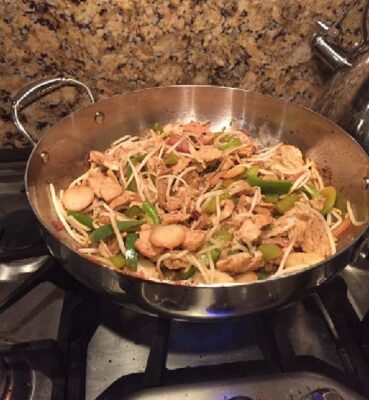
You may be wondering why cooking with a wok is different from using any other kitchen utensil. It is primarily due to the unique shape of a wok. As it is round at the bottom with sloped sides, you need to employ slightly different methods for cooking effortlessly.
Nowadays the flat bottom woks are dominating the market because of their compatibility on most of the stovetops. So if you have a flat bottom wok and want to cook with it on a gas stove, the tips I have listed here are equally useful and essential to make a tasty wok stir fry.
A wok allows even distribution of heat throughout the surface area. You can conveniently move the food around, thanks to the sloped sides. You can also turn on the flame without worrying about burning your food completely. However, you need to keep in check some crucial steps before that. The below 11 tips will work as a guide for you to cook with a wok on a gas stove like an expert.
11 Tips To Cook With a Wok on Gas Stove
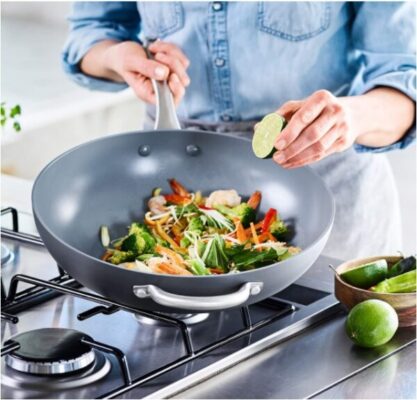
1. Wok size & Gas stove compatibility
Usually, when a beginner buys a wok, he/she never thinks about the heat source and the size compatibility of the wok. Whereas this is the biggest factor to look into. I cannot emphasize enough of its importance.
A larger sized wok needs more heating while cooking on a gas stove. If your wok is significantly bigger than your gas stove, your food will not get evenly heated.
A 14-inch wok or smaller has the ideal size and depth to cook on a gas stovetop. The bottom of the wok will get an ample amount of heat to make a delicious stir fry. However, to make it restaurant-style you need to follow other tips mentioned here in this guide.
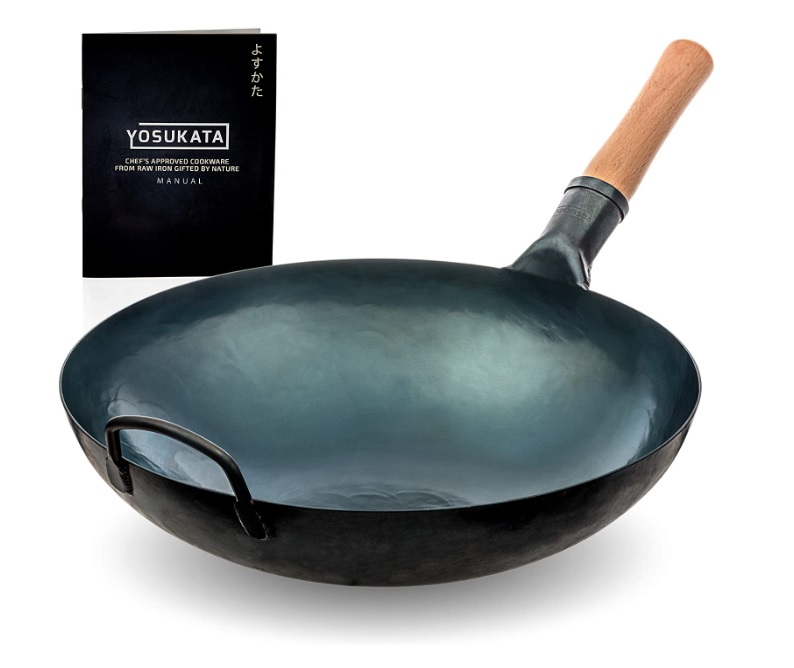
Any wok bigger than 14 inches might not get the right amount of heat, which in turn will make your stir fry taste like a boiled meal.
A 10 inch or 12-inch wok is more than perfect on a gas stove and if you only know how to control the heating during the cooking process (we will discuss that shortly), the stir fry will turn out lip-smacking tasty!
Clearly, effortless wok cooking on a gas stove is only possible when you pick the right size. If you are here to master wok cooking on a gas stove, chances are you already have a wok and there is no option to change it now. Don’t worry! I have solution for that too.
If your wok is bigger than 14 inch then below I have mentioned some useful tricks to solve that issue. Read on to know more.
2. Seasoning the Wok properly & More
We all know that a wok needs seasoning. If you are a beginner seasoning may feel like a troublesome task. But my greatest advice to you while cooking with a wok on gas stove, would be to master seasoning.
One who knows how to season a wok properly has mastered wok cooking halfway through. Seasoning is the first step to bring the ‘wok-hei’ flavor into your stir fry. If you are using carbon steel or a cast iron wok, you must season it before every use. I know many chefs will say seasoning once lasts many days.
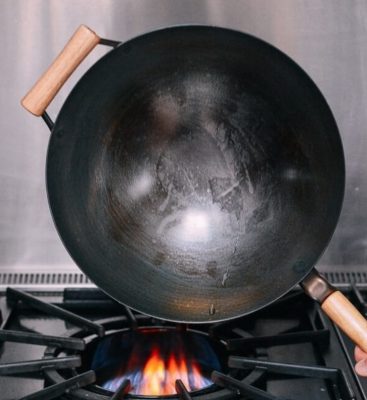
But think this through logically. You are using a wok daily, cleaning it, and thinking that the seasoning is intact even after rigorous high flame cooking and cleaning.
Even if you are not using the wok daily, storing for a while may end up losing the quality of the seasoning. I am not saying you cannot use once seasoned wok twice, but I am sure while cooking you will sense the difference.
To make your wok coking on gas stove as seamless as possible and your stir fry finger-licking tasty, using a properly seasoned wok is crucial.
Benefits of seasoning:
- Seasoning helps to develop a non-stick coating on your wok.
- Food will not stuck and get burnt easily.
- Seasoning helps in distributing the heat evenly so that the food gets cooked seamlessly.
- It also enhances the flavor when you cook.
- You will need less oil to make your meal.
- Cleaning is a breeze.
In case food gets stuck to the surface during cooking, which may happen if the seasoning is not done correctly, or the vegetables are not prepped the right way (we will talk about it in the tip number 6) gently scrape it off.
Wash your wok under running hot water. Pat dry the wok to remove all traces of moisture. Place the wok on high flame and liberally apply oil to the entire surface area. Leave the wok till the oil is completely absorbed.
To know how to season a wok properly you can read these articles.
3. Preheat Your Wok before Cooking
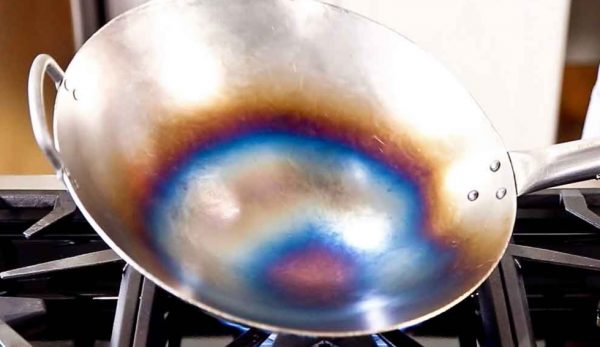
The crucial step for a good stir-fry is searing the ingredients at a blistering high flame. I would recommend leaving the wok on high heat for at least 10-15 mins before use. This ensures that the pan is smoking hot and produces the desired results. Traditionally, chefs place woks on volcano burners to guarantee optimal heat.
However, if you are using a non-stick wok, don’t heat it for too long. The coating may melt off completely. Woks with thin walls need very little time to heat up. Stainless steel woks need comparatively more time than carbon steel or cast iron wok to reach that optimum temperature.
Keeping that in mind you need to preheat your wok. To check if the wok is ready, do a water droplet test. If the droplet evaporates immediately, then your wok is absolutely ready to start cooking.
4. Choose the right oil
I cannot emphasize enough the importance of using the right oil. When amateur chefs cook with a wok on a gas stove, they tend to use whatever oil is readily available. This silly mistake can result in food getting burnt. Remember that cooking in a wok requires an extremely high flame. So opt for an oil that has a high smoking point.
For example, if you use olive oil and increase the heat, the oil will be completely smoked even before you put in the ingredients. I would advise you to go for grapeseed oil or canola oil for the best results.
The smoking point of oil means the temperature at which it burns and smokes. If you use an oil, having a low smoking point, as stir-frying in a wok needs high heat, soon the oil will burn and induce burnt flavor in your meal. When the oil is burnt not only that the flavor will get degraded but also beneficial nutrients and phytochemicals found in oil will be destroyed. Harmful free radicals increases in a burnt oil. Hence using oil with a higher smoking point is essential. Usually, the more refined an oil is, the greater the smoker point it has.
Because refining an oil reduces the number of impurities in oil, as a result chances of getting burnt decrease. Refined oil also has a neutral taste and odor. Clearly, it will not affect the flavor and smell of a wok cooked vegetable stir fry. So, if you are wondering how to stir fry vegetables in a wok properly? Change your oil first.
Here is a list of oils with their smoking points –
| Oil/Butter | Smoker Point |
| Walnut oil | 320 degrees F (unrefined) |
| Sunflower oil | 440 degrees F (refined) |
| Safflower oil | 450 degrees F |
| Peanut oil | 450 degrees F (Refined) |
| Light olive oil | 468 degrees F |
| Grapeseed oil | 400 degrees F |
| Flax oil | 225 degrees F |
| Extra virgin olive oil | 410 degrees F |
| Coconut oil | 350 degrees F |
| Canola Oil | 400 degrees F (Refined) |
| Butter | 350 degrees F |
| Almond oil | 430 degrees F |
| Avocado oil | 520 degrees F |
5. Small burners are better
When using a multi-burner gas stove, it is good to place the wok on the smallest burner. This helps ensures a concentrated flow of heat. Bigger burners end up sending the heat to the sides. You want the heat to be distributed throughout the vessel by concentrating it at the bottom where the ingredients are and for that, I always recommend using a high depth sturdy carbon steel wok pan as carbon steel is good at heat distribution.
6. Use the correct spatula
When cooking in a wok on gas stove, many chefs ignore the type of spatula they are using. As you may have noticed, this mistake costs you dearly. Ideally, you should get a specialized spatula that comes with a long handle. If you are not comfortable with a spatula, you can opt for a long Chinese ladle. You can also go for a slotted spoon. But having a spatula like this makes wok cooking so much easier.
If you are using a non-stick wok, make sure that you follow the instructions before using a spatula. For instance, you cannot use steel spatulas on Teflon coated woks.
7. Never add too much stuff
When you cook with a wok on gas stove, you want searing heat that uniformly cooks all the ingredients. This is not possible if you double the recipe or add too many ingredients. You may even end up with cold spots in your food. I have noticed that several amateur chefs make this mistake. So don’t forget to measure up the ingredients as per the size of your wok. Even if you follow a specific recipe, ensure that the quantity is correct to avoid any spillover.
After all, you want enough room to toss the food around comfortably and cook through thoroughly. Vegetables are full of water. If your wok is crowded with vegetables, then the chances are even if your wok is at extremely high temperature, veggies will not get enough heat to evaporate the water coming out of them.
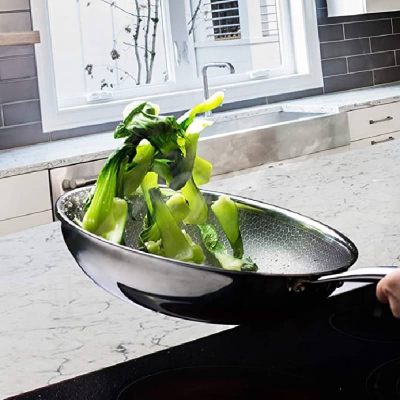
Then they will boil in their own water. Instead of stir fry, you will get steamed vegetables. Also, different recipes demand different ingredient sizes. But to cook stir fry vegetables in a wok, always go with the smaller surface area.
The lower the surface area the easier it to evaporate all the water from the veggies. When you are cooking on an electric, induction, or gas stove, even the highest heat is not enough to stir fry vegetables in a wok. Hence, to cook great wok stir fry on a gas stove you need to make sure the sizes of the ingredients are smaller.
Also, use a paper towel to soak up any water from the vegetables to ensure less work for your wok. This will definitely bring the ‘wok-hei’ flavor in your meal.
8. Use a wok ring
Another common challenge of wok cooking on a gas stove is that your wok may be wobbly. Due to its unique shape, many of you may have faced this issue. Purchasing a wok ring is an easy fix. It helps to keep the wok in its place while you are cooking. It also aids in regulating the heat.
There are various shapes and styles of wok rings available in the market. You will usually find carbon steel, stainless steel, or cast iron wok rings. I would advise you to take your wok along so that you can pick the correct one.
9. Thaw The Meat Properly
If you add meat straight from the freezer to the hot wok, it will instantly reduce the temperature. That defeats the whole purpose of using a wok. I would recommend thawing the meat completely before using it. If you are using marinated meat, drain off the marinade entirely before adding it to the wok. Wipe down the residual oil with a paper towel. If there are any food particles sticking to the pan, gently scrape them off.
10. Learn The Art Of Tossing
You decided to purchase a wok after watching chefs use it deftly to toss stir-fries. So it is time to learn to toss and flip yourself. It is a good idea to start with smaller quantities of food to avoid wastage. You can also watch online videos to master the technique.
11. Don’t forget to clean up
Let the wok cool down before you start cleaning. Remove all the residual material from the surface before using dishwashing liquid. I also advise using hot water to wash the wok. If your wok is rusty, use steel wool to remove the rust. Don’t forget to season it well.
Wrapping up
Wok cooking on a gas stove does not have to be intimidating. Like any new kitchen equipment, it takes time to learn the nitty-gritty about using a wok. By following these tips and practicing a couple of times, I know you will be able to ace it.
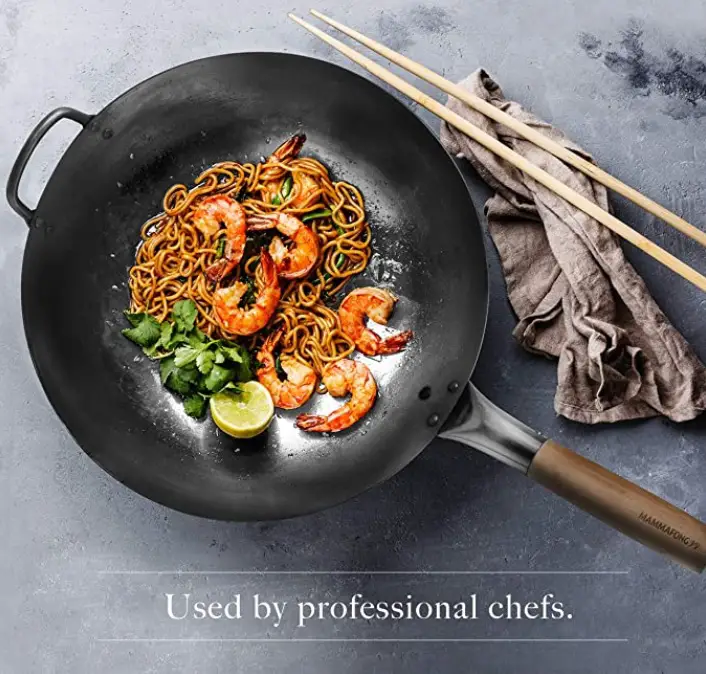
Best Carbon Steel Wok Recommended by Wokware
Mammafong 14 inch Traditional Hand Hammered Round Bottom Carbon Steel Pow Wok Set
Author: Preeunka
Editor at Wokware
She is an expert in the niche of kitchenware for 10 years now. She has given readers fact based, well researched, to the point answers of their valuable questions. Her goal is to simplify kitchen products and their utilities.


